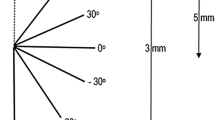Abstract
The close correspondence between the bills of hummingbirds and the lengths of the flowers they feed from has been interpreted as an example of coadaptation. Observations of birds feeding at flowers longer and shorter than their bills, however, and the lack of experimental evidence for any feeding advantage to short bills, seem to contradict this interpretation. I address this problem by considering a little-studied dimension of floral morphology: corolla diameter. In laboratory experiments on female ruby-throated hummingbirds (Archilochus colubris), probing abilities (maximum extraction depths) increased with increasing corolla diameter. Handling times increased with decreasing corolla diameter, resulting in “handling time equivalents”, i.e., flowers having the same handling times but different lengths and diameters. Longer-billed birds had greater maximum extraction depths and shorter handling times than shorter-billed birds at all corolla diameters greater than the width of the bill. In contrast, shorter-billed birds made fewer errors inserting their bills into narrow flowers. Hence, differences in bill lengths apparently are associated with trade-offs in foraging abilities, whereby longer-billed birds are able to feed at long flowers and may do so more quickly, whereas shorter-billed birds are able to feed more successfully at narrow flowers.
Similar content being viewed by others
References
Arizmendi MC, Ornelas JF (1990) Hummingbirds and their floral resources in a tropical dry forest in Mexico. Biotropica 22:172–180
Baldwin SP, Oberholser HC, Worley LG (1931) Measurements of birds. Cleveland Mus Nat Hist Sci Publ 2:1–165
Campbell DR (1989) Measurements of selection in a hermaphroditic plant; variation in male and female pollination success. Evolution 43:318–334
Campbell DR, Waser NM, Price MV, Lynch EA, Mitchell RJ (1991) Components of phenotypic selection: pollen export and flower corolla width in Ipomopsis aggregata. Evolution 45:1458–1467
Darwin C (1862) On the various contrivances by which British and foreign orchids are fertilised by insects. John Murray, London
Darwin C (1876) The effects of cross and self fertilization in the vegetable kingdom. John Murray, London
Ewald PW, Williams WA (1982) Function of the bill and tongue in nectar uptake by hummingbirds. Auk 99:573–576
Feinsinger P (1976) Organization of a tropical guild of nectarivorous birds. Ecol Monogr 46:257–291
Feinsinger P (1983) Coevolution and pollination. In: Futuyma DJ, Slatkin M (eds) Coevolution. Sinauer, Sunderland, pp 282–310
Fenster CB (1991) Selection on floral morphology by hummingbirds. Biotropica 23:98–101
Galen C (1989) Measuring pollinator-mediated selection on morphometric floral traits: bumblebees and the alpine sky-pilot, Polemonium viscosum. Evolution 43:882–890
Gosler AG (1987) Pattern and process in bill morphology of the great tit Parus major. Ibis 129:451–476
Grant KA, Grant V (1968) Hummingbirds and their flowers. Columbia University Press, New York
Grant V, Temeles EJ (1992) Foraging ability of rufous hummingbirds on hummingbird flowers and hawkmoth flowers. Proc Natl Acad Sci 89:9400–9404
Hainsworth FR (1973) On the tongue of the hummingbird: its role in the rate and energetics of feeding. Comp Biochem Physiol 46A:65–78
Hainsworth FR, Wolf LL (1976) Nectar characteristics and food selection by hummingbirds. Oecologia 25:101–113
Johnsgard PA (1983) The hummingbirds of North America Smithsonian Institution Press, Washington DC
Minitab (1989) Minitab reference manual release 7. Data Tech Industries, Valley Forge
Montgomerie RD (1984) Nectar extraction by hummingbirds: response to different floral characters. Oecologia 63:229–236
Roberts WM (1992) Hummingbirds' concentration preferences and the energetics of nectar-feeding: predictions, tests, and implications for optimal foraging theory and pollination biology. M. Sci. thesis, University of British Columbia, Vancouver
Siegel S, Castellan NJ Jr (1988) Nonparametric statistics for the behavioral sciences, 2nd edn. McGraw-Hill, New York
Smith CE, Stevens JT, Temeles EJ, Ewald PW, Hebert RJ, Bonkovsky RL (1996) Floral lips as nectar guides for hummingbirds: experiments on live and artificial flowers. Oecologia, in press
Snow DW, Snow BK (1980) Relationships between hummingbirds and flowers in the Andes of Columbia. Bull Brit Mus Nat Hist Zool 38:105–139
Stiles FG (1975) Ecology, flowering phenology, and hummingbird pollination of some Costa Rican Heliconia species. Ecology 56:285–301
Temeles EJ, Roberts WM (1993) Effect of sexual dimorphism in bill length on foraging behavior: an experimental analysis of hummingbirds. Oecologia 94:87–94
Wagner HO (1946) Food and feeding habits of Mexican hummingbirds. Wilson Bull 58:69–93
Whitten WM (1981) Pollination ecology of Monarda didyma, M. clinopodia, and hybrids (Lamiaceae) in the southern Appalachian mountains. Am J Bot 68:435–442
Wolf LL, Hainsworth FR, Stiles FG (1972) Energetics of foraging: rate and efficiency of nectar extraction by hummingbirds. Science 176:1351–1352
Author information
Authors and Affiliations
Rights and permissions
About this article
Cite this article
Temeles, E.J. A new dimension to hummingbird-flower relationships. Oecologia 105, 517–523 (1996). https://doi.org/10.1007/BF00330015
Received:
Accepted:
Issue Date:
DOI: https://doi.org/10.1007/BF00330015




